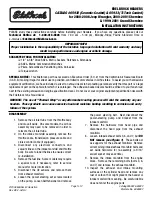
STARTING AND DRIVING
368
Winter driving
Check your vehicle before the approach of cold
weather.
The following advice is worth noting:
•
Make sure that the engine coolant contains
50 percent antifreeze. Any other mixture will
reduce freeze protection. This gives protec-
tion against freezing down to –31 °F
(–35 °C). The use of "recycled" antifreeze is
not approved by Volvo. Different types of
antifreeze must not be mixed.
•
Volvo recommends using only genuine Volvo
antifreeze in your vehicle's radiator.
•
Try to keep the fuel tank well filled – this
helps prevent the formation of condensation
in the tank. In addition, in extremely cold
weather conditions it is worthwhile to add
fuel line de-icer before refueling.
•
The viscosity of the engine oil is important.
Oil with low viscosity (thinner oil) improves
cold-weather starting as well as decreasing
fuel consumption while the engine is warm-
ing up. Full synthetic 0W-30 oil is recom-
mended for driving in areas with sustained
low temperatures.
•
The load placed on the battery is greater dur-
ing the winter since the windshield wipers,
lighting, etc., are used more often. Moreover,
the capacity of the battery decreases as the
temperature drops. In very cold weather, a
poorly charged battery can freeze and be
damaged. It is therefore advisable to check
the state of charge more frequently and
spray an anti-rust oil on the battery posts.
•
Volvo recommends the use of snow tires on
all four wheels for winter driving.
•
To prevent the washer fluid reservoir from
freezing, add washer solvents containing
antifreeze. This is important since dirt is often
splashed on the windshield during winter
driving, requiring the frequent use of the
washers and wipers. Volvo Washer Solvent
should be diluted as follows: Down to 14 °F
(–10 °C): 1 part washer solvent and 4 parts
water Down to 5 °F (–15 °C): 1 part washer
solvent and 3 parts water Down to 0 °F
(–18 °C): 1 part washer solvent and 2 parts
water Down to –18 °F (–28 °C): 1 part
washer solvent and 1 part water.
•
Use Volvo Teflon Lock Spray in the locks.
•
Avoid using de-icing sprays as they can
cause damage to the locks.
Related information
•
Snow tires and chains (p. 453)
Towing eyelet
When used, the towing eyelet should always be
securely attached in the openings on the right
side of the front and rear bumpers. There are
covers over these attachment points.
Using the towing eyelet
Take out the towing eyelet, which is stored
under the floor in the trunk.
Summary of Contents for S 90
Page 1: ...OWNER S MANUAL ...
Page 2: ......
Page 13: ...11 INDEX Index 535 ...
Page 14: ......
Page 15: ...INTRODUCTION ...
Page 57: ...SAFETY ...
Page 94: ......
Page 95: ...INSTRUMENTS AND CONTROLS ...
Page 177: ...CLIMATE ...
Page 201: ...LOADING AND STORAGE ...
Page 212: ......
Page 213: ...LOCKS AND ALARM ...
Page 242: ......
Page 243: ...DRIVER SUPPORT ...
Page 357: ...STARTING AND DRIVING ...
Page 401: ...INFOTAINMENT ...
Page 447: ...WHEELS AND TIRES ...
Page 468: ......
Page 469: ...MAINTENANCE AND SERVICING ...
Page 489: ...MAINTENANCE AND SERVICING 487 ...
Page 521: ...SPECIFICATIONS ...
Page 523: ...SPECIFICATIONS 521 Location of labels ...
Page 536: ......
Page 547: ......
















































